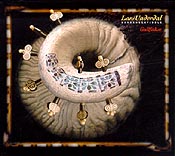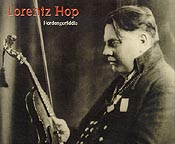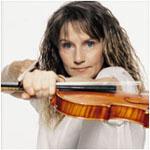Interviews
Annbjørg Lien
Mari Boine
American Tom Russell talks about his Nordic roots and his new music
Recent Reviews
Utla Dans (w/ audio)
Frå Senegal til Setesdal (w/ audio)
Fliflet / Hamre
Utla (audio special)
Knut Hamre & Steve Tibbetts
More Reviews
Arild Andersen
Various Artists
Book Review
Mari Boine
Knut Buen
Åse Feigland
Lorentz Hop
Jan Garbarek
Garnas and Garbarek
Isglem
Annbjorg Lien
Johan Sara Jr. Group
Lars Underdal
Suède-Norvège
Fiddling For Norway


![]()
Lars Underdal
Åse Feigland
Lorentz Hop
Lars Underdal comes from Telemark, Åse Teigland from Hardanger. They are part of a new wave of folk music in Norway, where youthful energy and creative spark flourish side-by-side with a deep sense of the tradition. These two young players are essential listening for any fan of fiddle music regardless of geographic interest or bias.
Both available at cdRoots
Chateau Neuf Spelemannslag
According to those who follow trends, big band music is enjoying a comeback on this continent. Across the Atlantic, Chateau Neuf Spelemannslag (CNS) is betting on the same kind of a resurgence. This Norwegian big band mixes traditional Norwegian folk material with jazz, swing, classical and even a bit of rock. They've been touted as one of the leading lights of Norwegian folk-based music.
The expected folk instruments are there -- the hardanger fiddle, the accordion, the recorder, but they are joined by clarinets, saxophones, piano, percussion and guitars. As is necessary for a "big" band, CNS has 16 musicians in total, a female quintet of vocalists and 11 instrumentalists. Stolen Goods has 16 tracks plus a surprise live version of "Miss Rowan Davies" at the end. They cover various dance types of Norway (e.g., hallings, reinlenders and springleiks), as well as some of the traditional song repertoire.
Five of the pieces are originals, singing the praises of blueberry pies, balding woodsmen and the first female bishop in the Church of Norway. It is bright, joyous and playful, ranging from the stirring unaccompanied vocals of "Do you want to make vows to me?" to the bass-driven rock groove of "The Mountain Girl."
Chateau Neuf Spelemannslag has the ability arrange a tune so that it builds and evolves. This skill is even more profound given the size of the band and their policy of arranging as a group. - Ivan Emke
Hege Rimestad
Agnes Buen Garnas And Jan Garbarek
The voice of Agnes Buen Garnas is a fine and beautiful thing; pure, controlled and passionate. The songs are all from Norwegian tradition, medieval tales told on bitter cold nights to help suffer the cold winds, and her voice is the warmth of a fire blazing at midnight. The twist in this recording is the work of Jan Garbarek, whose synthesized sounds carry these tunes beyond Norway into a sort of pan-European dark ages of the future. There is a heavy Balkan sound to these songs, which may or may not have anything to do with historical traditions, but as new music, it really works. Even without the benefit of knowing the stories told in this all-Norwegian-language piece, you still can feel the joy and sorrow of the tales as they unfold. The cross references of garbarek's moody music with Garnas' incredible, formal folk voicing is quite stunning. No recommended cuts, in fact my suggestion is you treat it as a whole piece, played in one set on a dark night somewhere in a cold world. - CF
Isglem
Totally stripped down, raw horn and percussion music is what's delivered here by outside saxophonist Karl Seglem and crazy percussionist Terje Isungset. Null g is free jazz with a heavy dose of primitive folk, as they experiment with all manner of ancient instruments and rhythms in a variety of settings from ambient to total chaos. Sleigh bells clash with goat horns and sax meets drum kit on some barren, non-melodic plain. This is not easy listening, but it's an adventurous experience for the strong headed and hearty. - CF
Available at cdRoots
Annbjørg Lien
Annbjorg Lien
This 25-year-old Norwegian plays the traditional hardanger fiddle, but in many ways breaks tradition. First, there are few if any women who have mastered the fiddle, which has a set of sympathetic steel strings. And with this, her second solo album, Lien creates music that uses Norwegian elements but is not limited by them.
This luminous instrumental album at times is reminiscent of Irish traditional -- and neo-traditional -- music. At times, with the plucking of a Swedish bouzouki or a touch of reed organ, the music can sound vaguely African or even baroque. Lien, who wrote all the album*s compositions, is also not afraid of adding touches of modern electronics, notably on the appropriately multi-hued title cut, which translates to 'prism.'
While Lien has won championships for playing dance music, the album is not a collection of the Norwegian equivalents of speedy jigs and reels. The album does, however, have a vibrant energy. With her troupe of excellent back-up musicians, Lien pays tribute to folk music by playing with taste and feeling, but also shows herself to be thoroughly contemporary in her willingness to incorporate diverse elements to serve the songs. - Marty Lipp
Annbj�rg Lien
While Hedningarna and Garmarna have taken the music of Scandinavia into the rock and pop realm with great success, fiddler and composer Annbjorg Lien has chosen a gentler approach to her music over the years. It has sometimes resulted in music that was "lite" rather than just light, and her recorded output over the years has featured brilliant performances coupled to a tendency towards trivial arrangement and production.
She has produced a fine album of Norwegian folk music that pushes borders with unusual arrangements and strong performances not only by her, but an impressive supporting cast. Joining her in both arranging and performing, are Roger Tallroth (guitar, bouzouki and mandolin) and Mikael Marin (viola), both members of Swedish folk ensemble V�sen, and Bjorn Ole Rasch, who offers organ, piano, and electronic keyboards that finally allow the music some room instead of stifling it with programmed stiffness. Rune Arnesen adds all manner of percussion and Hans Fredrik Jacobsen contributes bagpipes, kantele (Finnish zither) and flutes.
This is a strong ensemble work, with vivid passages of instrumental jousting among the players. But at it's core is still the fiddle music of Norway, music for the drone and keyed fiddles that make both the sound and melody of the music so unique to the region. Lien is a master craftswoman, something we've known for a long time. With Prisme she takes her place in Scandinavia's master-artist class, with a work that transcends skill and source material and lives a new life. - CF
Mari Boine
I've waited years of a US release of something from this remarkable singer, ever since her compilation on Real World introduced her to a wider audience in Europe and America. She has since produced a number of albums, each a tribute to her Sami roots in Lapland and her own vast ability to innovate and interpret. Radiant Warmth, taken in a vacuum, is a wonderful album of individual songs, each using a band that spans the musical spectrum, musicians skilled in rock, jazz and folk from around the world, playing off her reinterpretations of Scandinavian folk and ancient northern joiking. They freely mix progressive rock guitar licks with Sami drums and South American flute music, unconcerned with "authenticity" and totally concerned with artistic introspection.
The (minor) downside of Radiant Warmth is that it too is a compilation, of two earlier albums, Goaskinviellja (1993) and Leahkastin (1994). These albums should be heard as whole works, because they follow both a lyrical and musical course that takes the listener on an aural journey through her Sami world. Either of these works would have made a worthy reissue in the US, and since neither is readily available here, it seems a shame not to invest a little extra in making them both fully available. But, this is a minor quibble for radio, because there's not a track on the set that is less than wonderful, each worthy of your air-time.
Johan Sara Jr. Group
Here is an artist, a writer and singer who prefers to explore the outside edge, yet does it from within the deepest part of his own tradition and culture. Sara is a joiker, a singer of the ancient Sami songs of Lapland. These songs are unique, vocally challenging pieces of ancient history, usually sung unaccompanied, or with just a frame drum or some simple, single-tone instrument. But Sara has gone well past that, and has assembled an ensemble of flutes, stringed instruments, percussion and even electric bass and synthesizers to make the music into something personal, expressive and yet still contemporary. There are elements of lower-Scandinavian folk, European pop music and jazz, and even hints of Latin rhythms in some of the more percussive pieces. What makes this album work is that they almost never take the easy way out by catching a familiar phrase and playing it to the crowd. The familiarities come in unexpected places, and disappear just after you settle into them, taking you down unexpected roads to places that neither history nor tradition had led you to expect. The ensemble stays true to its roots (and maintains a primarily acoustic setting) even as it looks to surprise and expand.
Suède-Norvège: Musiques des Vallèes Scandinaves
This album features a wonderful cast of performers, all of them stars of the Swedish and Norwegian folk scenes: Ale Möller (mandolin, flutes), Lena Willmark (voice, violin), Kirsten Bråten-Berg (guimbarde, voice), Per Gudmundsun (violin and bagpipes), and Gunnar Stubseid (hardingfiddle). Recorded live in concert, and in the studios of Radio France, these 31 acoustic songs and tunes are a magnificent introduction to the folk music of Norway and Sweden. Each artist is recognized for their skill and innovation on their instruments, and the voices of Braten-Berg and Willmark are among the best in Scandinavia. While all the players are better known for their modern fusion work, on this set it's almost all traditional tunes, played with spirit and beauty.
Jan Garbarek
Garbarek albums are always such a love-hate thing for me. There are aspects of his musical vision that drive me to distraction; his need to be smooth, his penchant for sonic triviality. BUT... he is also one of the most innovative composers and arrangers in contemporary music. His talent for spotting a melody and exploiting it in new and creative ways is remarkable, and Twelve Moons offers many of those moments. "Psalm" finds him reunited with Norwegian vocalist Agnes Buen Garnås, in a piece of subtlety, texture and icy beauty. His affinity for the folk music of Scandinavia makes their duets intense, and his delicate use of Marilyn Mazur's percussion and Eberhard Weber's bass enhance and amplify the rarified atmosphere of this traditional song. The other vocal piece on the album is "Darvanan," a sax and vocal duet with Sampi singer Mari Boine. They twist and weave around each other's melodies, echo one another's energy, and create a chilling effect. An instrumental piece that comes close to these is another folk song reinvented by Garbarek as "Gautes-Margjit," adding Rainer Bruninghaus on piano and Manu Katché on kit drums. "Huhai" takes a traditional Sampi joik and blends into a driving jazz tune. A quartet of piano, sax, bass and drums winds out the album with a version of Jim Pepper's native American jazz suite "Witchi-Tai-To" which exemplifies my relationship with Garbarek's music perfectly. It is alternately rhythmically exciting and overly lush. Gorgeous, trite, joyful, maddening! Why do I recommend such an album? Because when its right, it is better than anything else around.
JAN GARBAREK, USTAD FATEH ALI KHAN AND MUSICIANS FROM PAKISTAN
ZAKIR HUSSAIN AND THE RHYTHM EXPERIENCE
Here are two exceptional albums of Asian fusion, one with an American perspective, the other from Scandinavia. Garbarek has always traveled to exotic places, and joining forces with Ali Khan and company has enhanced both of their catalogs. Ragas and Sagas is primarily an album of Pakistani music, augmented and twisted by Garbarek's input on horns and synthesizers. All but one track ("Saga," mostly a duet between Garbarek and drummer Manu Katche) are Ali Khan compositions, and feature his rich percussive voice and that of Deepika Thataal. Tabla, sarangi and horn are the basics, touched here and there by synths and an uncredited (or sampled?) harmonium. Eerie at times, complex and yet soothing, these pieces defy the usual "new age" tag associated at times with both Garbarek and Ali Khan. Neither traditional nor modern, they occupy their own time and place, touched by history but also removed from it.
Hussain has been at the forefront of the jazz-goes-east movement for a long time, pairing himself up with notables from both worlds like Shankar, Mickey Hart, John McLaughlin and many of ECM's artists over the last two decades. Not only is he a master musician, but a master of new form, capable of the most out-side experiments without losing sight of the traditions that inspire him. The Rhythm Experience was formed in 1984 to explore the many percussion instruments and styles of the world. This album travels through the islands of Java and Bali, the Indian sub-continent and the jazz clubs of America, making one of those rare recordings that may genuinely carry the name "world music." Tar, talking drum, marimba, guiro, kwika, electronic effects and shakers transcend the usual "drum jam" blandness that most ensembles like this seem to fall prey to. Here they become breathing, exciting voices calling the listener into a world both distant and familiar. The resulting tracks can be light and breezy ("Nines Over Easy") or powerful and dramatic ("Rhythm Sonata In E Major"). My personal choice for airplay is the funky groove of "Rapanagatun," which pairs rock kit drums with Indian vocalese and tuned drums for melody. Hussain has again found new music in his ancient roots.
Arild Andersen
This is really so much a group effort that all the players should be named first: Andersen composes and plays bass; Bendik Hofseth, saxaphones; Frode Alnaes, guitar; Bugge Wesseltoft, keyboards; Nana Vasconcelos, percussion; and an absolutely transcendant vocalist, Kirsten Br�ten Berg. The approach is now somewhat familiar. Take the folk melodies of somewhere, and pull them into a more modern jazz or rock influenced framework, and make them accessible. Where this work differs is that it neither bows to tradition nor cowers before technology. It does cling to that classic "ECM" sound of soprano sax and droning synthesizer, but it surpasses expectations in its suprising touches. Part one moves from smooth jazz to folk melody to a sort of gypsy funk, capturing a local feel with an international sound.
The juxaposition of Afro-Brazilian groove with wah-wah guitar, soul with ancient Scandanavian melody is blended together with creative finesse and respect for all the musical styles and musicians involved. To single out the skill or improvisational inspiration of any single player here would be pointless. Each seems free to add and subtract at will to the structure provided by composer Andersen. This music alternates between icy, austere beauty and warm, melodic soul.
Knut Buen And quick he is, on his elaboratly embellished Norwegian hardanger fiddle. It's blend of folky bowed notes and droning sympathetic strings makes the instrument unique in Europe, and Buen's playing honors it. This is a straighforward recording, with no fusion or features, just hardy, solid fiddling in the folk tradition.
Book Review:
Norway is blessed with two types of folk violin, the famous Hardanger and
the standard fiddle. As Dr. Goertzen explains, the latter and its specific
repertoire, is as common, but suffers from lack of exposure
due to the former being held as a cultural icon of Norway. This book
examines the fiddle and, unavoidably, always in its relation to Hardanger.
The book examines the history of fiddling in Norway, stressing that
country's folk revival of the past fifty years. Of special interest to some
readers will be the key place of contests in this revival. The
controversies concerning this are similar to what is taking place in the
United States with regards to the so-called "national contest style"..
Goertzen investigates the judging process and how traditional performance
values (eg. dance-ability) conflict with art music esthetics that often
drive the decision making process. These tend to eliminate relatively
simple tunes that work well at dances and hastens the (seemingly
inevitable) homogenization of regional differences.
There are 127 detailed transcriptions of mostly two part tunes, many of
which are metrically crooked (in the number of measures per section). The
performance practices of playing this music is discussed in detail. An
accompanying tape of this hard-find-find music (at least in America) would
have been a big help.
This is academic work, with data and detail, but it is very readable
without unnecessary jargon (though the musical analysis does employ some
musicological terms). My favorite fact - many counties in Norway partially
subsidize folk fiddlers! - Stacy Phillips
Other music from Scandinavia and Europe
Gullfakse
NOR-CD
Dansarsteinen
NOR-CD
Hadangarfiddle
NOR-CD (home.sol.no/~norcd/ )
 The Hardanger fiddle (hardingfele) may very well be the most familiar sound of Norway, with artists like Annbjørg Lien bringing the instrument to world-wide attention throughout the 1990's. Its unique ambiance comes from the more traditional four-string violin being coupled with sympathetic strings and a more open, echoed sound from the box.
The Hardanger fiddle (hardingfele) may very well be the most familiar sound of Norway, with artists like Annbjørg Lien bringing the instrument to world-wide attention throughout the 1990's. Its unique ambiance comes from the more traditional four-string violin being coupled with sympathetic strings and a more open, echoed sound from the box.
 Lorentz Hop is one of those members of the "tradition" that the new players look to in Norway. These recordings come from sessions done by The Norwegian Broadcasting System in 1946, 1947 and 1951, just a few years before his death. They show a burly player, a musician who understood the raw energy and sheer force that could be applied to an instrument more commonly associated with delicacy. He also displays a certain wit that only comes from confidence, and the bird-like trills and choppy strokes that pepper his music add a charming personality to the mix. - CF
Lorentz Hop is one of those members of the "tradition" that the new players look to in Norway. These recordings come from sessions done by The Norwegian Broadcasting System in 1946, 1947 and 1951, just a few years before his death. They show a burly player, a musician who understood the raw energy and sheer force that could be applied to an instrument more commonly associated with delicacy. He also displays a certain wit that only comes from confidence, and the bird-like trills and choppy strokes that pepper his music add a charming personality to the mix. - CF
Stolen Goods
NorthSide (www.noside.com)
White Arrow
NorthSide (www.noside.com)
 A novel entry of contemporary folk-inspired music for standard violin (ok,
fiddle), various hand percussion, electric guitar, fretless bass, and
female vocalists. Rimestad's work departs from more traditional fare in the
percussionless breaks, provocative compositions and presentation of violin
and guitars with spatial effects. A few of the pieces here are stunningly
impressionistic, seemingly carved out of the very air, culminating with the
visceral sparkle of "Tonal Gravity." Very much in the spirit of Mari
Boine's impressive second album Gula Gula, White Arrow happens to feature
Boine on "Delivering the Lights" and two long-time bandmates on a handful
of other cuts. Sitar and tabla make appearances on a few tracks and the presence
compliments the dominant Nordic instrumenation so well that one hesitates
briefly to believe they may have originated there. Overall, White Arrow's
magic rides on non-repetitive ornamentation of solidly simple melodies. It
nibles at the edges of real, "new music" innovation, hanging right there between folk heritage and the tomorrow of something altogether different. This is a fine sounding recording, a bit
bright (i.m.o.) and not as warm as Boine's Rainbow Studio album, but
ultra-dynamic just the same. Selfish reviewer post-script: Now if someone
could cut the traditional syntax further and wander by chance into an even
more baroque, open-ended realm of extended folkloric sound
scultpure...(sigh). - Steve Taylor
A novel entry of contemporary folk-inspired music for standard violin (ok,
fiddle), various hand percussion, electric guitar, fretless bass, and
female vocalists. Rimestad's work departs from more traditional fare in the
percussionless breaks, provocative compositions and presentation of violin
and guitars with spatial effects. A few of the pieces here are stunningly
impressionistic, seemingly carved out of the very air, culminating with the
visceral sparkle of "Tonal Gravity." Very much in the spirit of Mari
Boine's impressive second album Gula Gula, White Arrow happens to feature
Boine on "Delivering the Lights" and two long-time bandmates on a handful
of other cuts. Sitar and tabla make appearances on a few tracks and the presence
compliments the dominant Nordic instrumenation so well that one hesitates
briefly to believe they may have originated there. Overall, White Arrow's
magic rides on non-repetitive ornamentation of solidly simple melodies. It
nibles at the edges of real, "new music" innovation, hanging right there between folk heritage and the tomorrow of something altogether different. This is a fine sounding recording, a bit
bright (i.m.o.) and not as warm as Boine's Rainbow Studio album, but
ultra-dynamic just the same. Selfish reviewer post-script: Now if someone
could cut the traditional syntax further and wander by chance into an even
more baroque, open-ended realm of extended folkloric sound
scultpure...(sigh). - Steve Taylor
Rosensfole
ECM
Null g
NOR-CD ([email protected] )
Felefeber
Shanachie
You heard a few small samples of this amazing fiddlers work on the Kaiser and Lindley expedition. Now you get the full effect of this musician who has been the talk of the European folk circuit for a few years now. Lien and her amazing band (organ (Iver Kleive?) guitars (Roger Tallroth?), and some marvelous singer, all left a mystery in Shanachie's ever-minimal liner notes) travel though Norway's traditions and a number of stunning original tunes, including a great take on an Irish classic. Possibly the best of these songs is Lien's "The Battle Of The Drones," with it's resonant Hardanger (drone) fiddle and it's lively guitar accompaniment. On the traditional side is "Springar After Kristiane Lund," a tribute to one of the great fiddlers of this century played here with a rich church organ backing. Lien extends the tradition without ever getting too clever or daring. Unlike progressive innovators like Mari Boine, she finds her inspiration in the simplicity and open spirit of history. - CF
Prisme
Prisme
Shanachie
Radiant Warmth
Antilles
Ovcci Vuomi Ovtta Veaiggis
DAT, Pb 31, N-9520 Gouvdageaidnu, Norway fax: 47.7848.6788
(Ocora, via Harmonia Mundi)
Twelve Moons
(ECM)
Ragas And Sagas
ECM
Moment, 321 San Anselmo Ave., San Anselmo, CA 94960/415-459-6994
Sagn
ECM
As Quick As Fire
(Henry Street, via Rounder)
Fiddling For Norway
by Chris Goertzen
(University of Chicago Press, 347 ppg, $22.50 paperback)
This book is available from cdroots.com
Back to the top
